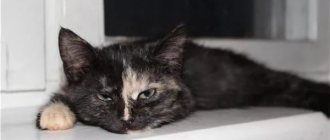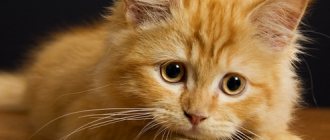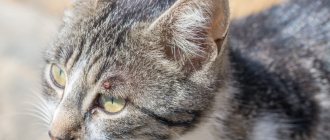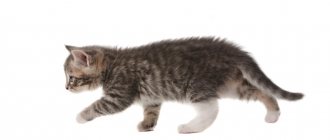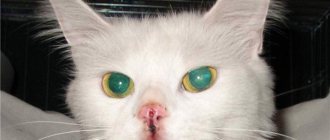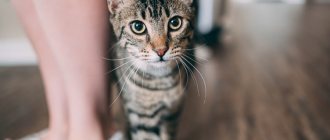Inflammation of the mammary glands
- Fact 1:
It is quite difficult to detect mastitis at the initial stage. - Fact 2:
If you delay a visit to the veterinarian, then, most likely, taking medications and massage will no longer be enough - Fact 3:
The hemorrhagic form is the most severe. Extensive bleeding occurs in the skin and mammary glands - Fact 4:
Diagnosing the disease yourself is difficult
Mastitis is an inflammation of the mammary glands, either one or several at once. Animals during lactation, pregnancy or false pregnancy are at risk. The development of the disease goes through several stages. The initial one heals quickly. Treatment at home is possible. The disease, which has taken a severe form, often requires immediate surgical intervention.
The first signs of the disease
It is quite difficult to detect mastitis at the initial stage. Firstly, many pregnant or lactating cats do not like touching their bellies and try to avoid them. Secondly, in pets with thick hair it is not so easy to see the nipples, which become swollen and red as the disease develops.
The first signs indicating any deviation are often changes in the cat’s behavior:
- she begins to lick her breasts frequently;
- sometimes refuses to eat;
- After feeding the offspring, she looks lethargic and apathetic.
In this case, you need to examine the mammary glands. If the nipples and the tissue around them are red and swollen, and the body temperature has increased, we can talk about the development of pathology. It is better to immediately contact a veterinary clinic.
Treatment of the disease in the initial stages, as a rule, is limited to conservative methods, does not require surgical intervention and ends successfully. If you delay a visit to the veterinarian, then, most likely, taking medications and massage will no longer be enough.
Characteristics of mammary cancer in cats and its causes
Mammary cancer in cats is a mutation of cells that rapidly divide and form a lump on the breast. As the disease progresses, pathogenic cells enter the lymphatic and bloodstream, which carry them throughout the body. As a result, the cat develops metastases, characteristic of late stages of cancer. It is already very difficult to cure the disease at this stage.
The causes of mammary cancer in cats are not fully understood. However, among the main ones, scientists name the use of hormonal drugs that inhibit the functioning of the ovaries. Owners often give such remedies to their pets in order to suppress sexual desire and save the animal from suffering and themselves from troubles.
Another factor that can trigger the development of cancer in a cat is genetic predisposition. In the vast majority of cases, a malignant lump on the chest appears in older cats. If the animal is one or two years old, the risk is practically eliminated. Pets under seven years of age suffer from cancer extremely rarely. The average age of cats with cancer is 10 years.
A pet that has been neutered before its first heat will never encounter a malignant lump on its chest. Cats that have had time to go for a walk before sterilization can get sick. However, the main risk group is still uncastrated elderly individuals who are often given hormonal drugs. The impetus for the development of the disease can be poor nutrition, stress, and unfavorable environmental conditions. In this regard, cats are just like people.
Causes
There are many reasons why mastitis begins to develop. At risk are animals with weak immunity, low body weight, or those who have just acquired any disease.
Other factors that provoke the development of the disease:
- bruises;
- hypothermia;
- mammary gland injuries;
- infection or fungus - inflammation occurs when bacteria penetrate through micro cracks in the skin or due to the influx of infected blood from internal organs during a systemic disease;
- complications during or after childbirth;
- stagnation of milk due to early weaning of kittens, small number of cubs in the litter, death of offspring;
- false pregnancy.
As a rule, mastitis develops under the influence of several factors, and is not a consequence of one.
Benign lumps on cats chest
A tumor on the mammary gland in a cat can be benign, but this is very rare. If the lump is not formed due to cancer, it is characterized by the following features :
- slow growth;
- mobility;
- there is no vascular network on the cone;
- there is no metastasis.
Treatment of such breast tumors depends on many factors. The size of the tumor, the age of the cat, the general condition of its body, etc. are taken into account. Conservative therapy is most often used. Surgical treatment is indicated only in extreme cases: if the lump is very large, or there is a risk of malignant degeneration of the tumor.
Kinds
There are several forms of the disease. The initial stage is usually accompanied only by redness and slight swelling of the nipple, and a slight increase in body temperature. It often goes unnoticed by humans. If left untreated, it progresses to more severe forms of mastitis:
- Serous . The mammary glands enlarge significantly. They become hot and hard, and the cat reacts painfully to touch. When pressed, liquid with white flakes is released from the nipple.
- Catarrhal . When pressed, a liquid is released, the consistency of which is similar to sour milk.
- Fibrinous . Characterized by increased body temperature and enlarged lymph nodes. On palpation, “crunching” sounds are heard.
- Purulent - a complication of previous forms. An unpleasant-smelling fluid mixed with blood and pus is released from the chest. In most cases, at this stage the disease becomes chronic. The mammary glands fill with connective tissue, which can lead to a lack of milk in the future.
The hemorrhagic form is the most severe. Extensive hemorrhage occurs in the skin and mammary glands, staining the tissues bright red. The animal's temperature rises and it becomes feverish. Surgery required.
Diagnostic measures for suspected cancer
It is impossible to independently determine the nature of a lump on a cat’s chest. Only a professional doctor can do this. In a veterinary clinic, the doctor carefully examines the animal’s mammary glands and other parts of the body; by palpation will determine the characteristics of the lump, its volume, consistency, skin temperature, etc. Then he will prescribe laboratory and hardware diagnostic methods, including :
- urine and blood tests;
- X-ray;
- Ultrasound.
© shutterstock
If cancer is suspected, the cat will undergo a biopsy by pinching off a piece of the lump under anesthesia and sending the pathogenic tissue for examination. Specialists will determine whether malignant cells are present in it.
How to tell if your pet is sick
You need to monitor your pet's behavior and well-being very carefully. Especially during such an important period of life as pregnancy and feeding offspring. This is always stressful for the body, which means the cat is more susceptible to various infections and diseases.
Symptoms of mastitis in the first stage:
- redness of the nipples;
- slight swelling and compaction;
- increase in body temperature;
- the occurrence of microcracks;
- discharge of a curdled mass when pressing on the chest.
The pet reacts painfully to any touch and often licks its tummy.
As mastitis moves to the next stage, redness and swelling increase, the temperature consistently exceeds the norm by at least 1C, and the tissue around the mammary glands becomes very hard. When pressed, a yellowish or grayish liquid with drops of blood or pus is released.
In these cases, immediate contact with a veterinarian is required. If this is not done, the disease becomes more severe. The animal shows the first signs of intoxication of the body - apathy, fever, weakness.
Symptomatic picture
With cancer, the appearance of lumps on a cat's chest may not be immediately detected. At the first stage, the nodules are very tiny. Their maximum size is 1-1.5 cm, and since they are hidden under the fur, the owner does not pay attention to them. The behavior of a cat in the initial stages of mammary cancer also remains normal. She eats normally and is as active as before.
© shutterstock
Alarming symptoms often appear only at the 3rd stage, when the lump reaches a size of 3-5 cm. It is characterized by the following features :
- clear boundaries;
- immobility;
- dense consistency;
- the temperature of the skin over the tumor is not increased;
- slight soreness.
With advanced mammary cancer, the lump becomes covered with ulcers that open and bleed, causing severe pain to the cat. The animal looks depressed, loses appetite and sleep, and loses a lot of weight. Lumps may appear on other parts of the body - limbs, neck, head. These are metastases.
Malignant bumps differ from benign ones, first of all, by their rapid growth. If the tumor was small a week ago, but has now reached several centimeters, the cat should be urgently shown to a doctor. The sooner treatment is started, the better.
Diagnostics
It is difficult to diagnose the disease on your own. Therefore, at the slightest change in the behavior of a nursing or pregnant cat, it is better to consult a veterinarian. In order to understand that something is wrong with your pet, you need to carefully examine its mammary glands and abdomen. If the nipples have increased in size, become dense and hot to the touch, and look inflamed, we can talk about the development of mastitis.
You can make sure the diagnosis is correct by gently pressing on the nipple. You need to do palpation yourself carefully, since the inflamed glands cause severe pain to the animal. If uncharacteristic discharge appears, you should definitely consult a doctor.
Another sign indicating negative changes in the body is increased body temperature. In the first stages, it is 1–2 °C higher than normal.
Therapy for cancer
Treatment for mammary cancer in cats is usually surgical. Not only the tumor on the mammary gland is removed, but also the entire number of glands. And sometimes it is necessary to amputate both rows with deep involvement of the subcutaneous tissue, which is called a total mastectomy. If there are affected lymph nodes, they are also removed.
Such radical measures are necessary in order to reduce the risk of the oncological process spreading from the lump to neighboring tissues. After all, one remaining cancer cell is enough for the process to resume.
In addition to surgery for mammary cancer in cats, chemotherapy is sometimes indicated. It is carried out under the supervision of a specialist. This treatment should be taken very seriously, doing everything strictly according to the protocol. Chemotherapy exhausts a cat's body.
A large number of medications are required that will have a supporting effect and will not allow other diseases to take hold. Chemistry almost completely kills the immune system. During this period, the cat can die from any draft. The animal needs good care.
Chemotherapy alone is rarely used to treat breast cancer . More often it is combined with surgical removal of the lump and nearby tissues. Sometimes radiation is used instead of chemotherapy. In some cases, all three methods are combined.
Specialists undertake to treat malignant lumps in cats in the early stages, when the prognosis is still quite favorable. In advanced situations, any therapy is useless. She will only torment the cat. If stage 4 has already occurred, veterinarians usually recommend euthanizing the unfortunate animal.
© shutterstock
Treatment
If mastitis is detected in a timely manner and a visit to a veterinary clinic is performed, surgical intervention can be avoided.
Often only conservative methods are sufficient. In order to choose the right treatment regimen, the owner is usually asked to tell how the birth and pregnancy went, and they are asked general questions about the cat’s health. This allows you to identify the cause of mastitis and prescribe the correct treatment. This means that it will facilitate and speed up the recovery process for your pet after an illness. Before you start taking medications, your cat will have to undergo tests. To do this, a drop of fluid from the mammary glands is taken for laboratory testing. These actions reveal the nature of inflammation.
After the preparatory stage and receipt of test results, the doctor prescribes treatment. If mastitis becomes severe, antibiotics are prescribed. Such measures make it possible to stop the inflammatory process and prevent its spread to surrounding tissues. As an auxiliary therapy the following is prescribed:
- massage;
- expressing milk;
- washing inflamed areas with infusions of medicinal plants (chamomile, sage, oak bark);
- treating nipples with products for external use that relieve inflammation and external symptoms.
It is recommended that cats reduce the amount of water they consume. Temporarily switch to feeding dry ready-made formulas.
Only the most severe forms require surgical intervention, when mastitis develops in several mammary glands at once, they become clogged, and impurities of blood and pus appear in the milk. In this case, kittens are taken away from their mother without fail.
Factors contributing to successful mating
Domestic cats become sexually mature at 6–8 months, depending on the breed and individual characteristics. Neither males nor females are ready for full mating in the first “hunt”. Stray animals mate at this age, which leads to death or infertility in an average of 30% of females, a reduction in sexual productivity in 50% of males - a natural way of controlling the birth rate and population of wild animals.
It is believed that the female is ready to bear kittens at the age of 1.3–1.5 years. For successful “cooperation” with a cat, the owners of the female need to take into account several points:
- The search for a “spouse” may take a long time; you need to start 4–6 months before the planned mating. Remember that animals may not like each other, so have a backup plan.
- Three months before mating, cats must be examined for infectious diseases, and tested for viruses a month before.
- The cat is not vaccinated for 14–20 days.
- Preventive deworming is carried out 14 days in advance.
- Future partners do not bathe and trim their nails immediately before mating.
- The meeting takes place on the territory of the cat; appropriate conditions must be prepared for the female.
Important! If your pet is not of breeding value and you do not plan to have offspring, the animal must be sterilized at the age of 7–12 months. The period is considered optimal - the animal’s hormonal levels have established, but it is not yet ready to mate. According to international rules for keeping pets, all animals that do not represent breed value or have genetic abnormalities must be sterilized.
How to avoid illness
In order to avoid developing mastitis, you need to take some precautions that will help avoid problems in the future. Very often the cause of the disease is hypothermia, so a pregnant or lactating cat should live in a warm and dry room without drafts. It is better to move a pet living outside for a while indoors.
The second common cause of mastitis is infection. Kittens may accidentally scratch or damage the skin around their nipples while feeding. This, in turn, will lead to infection in the wounds and inflammation. You can avoid this outcome by regularly removing animal bedding and washing the kittens’ paws. A person should wash their hands thoroughly before touching a cat's belly.
A preventive measure that is of great importance is a proper balanced diet. You can choose special dry food for your pet. It would be good if it belongs to the premium class. Before purchasing a mixture, it is better to consult a veterinarian or breeder so as not to harm the health of the animal.
It is very important to wean kittens correctly. When babies begin to eat on their own, the cat's mammary glands need to be bandaged. This way you can reduce the amount of milk produced and protect your pet from infection.
